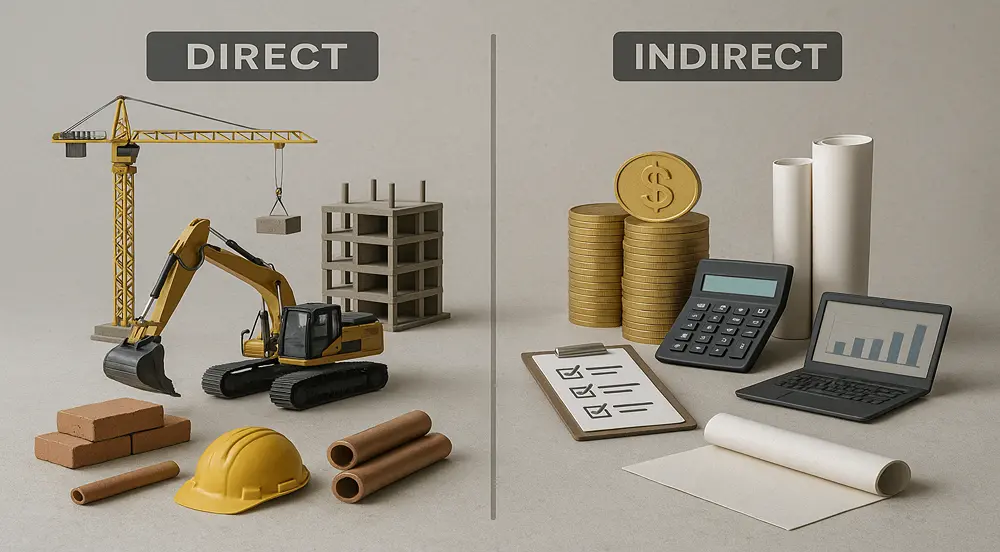Labour and materials define direct costs, while supervision, insurance, and administration define indirect ones. Understanding this distinction in Direct vs Indirect Costs in Construction enhances estimating accuracy and profitability, with ACIF 2024 showing projects that apply clear cost separation reduce budgeting errors by 27%, ensuring long-term financial stability.
Comparing Cost Control Challenges Between Direct and Indirect Expenses
Effective budgeting hinges on tracking direct costs like materials and labour, which are project-specific and easier to monitor. Poor management can inflate expenses rapidly, impacting profitability. According to ACIF 2024, poor indirect-cost control raises total project costs by up to 12%.Direct Costs vs. Indirect Costs: Definition, Examples And How To Calculate
Indirect costs, such as office leases and compliance, demand rigorous oversight to avoid overspending. Unlike direct costs, these are harder to allocate accurately, requiring robust systems. Implementing clear tracking supports initiatives like designing to reduce construction costs, enhancing overall efficiency.
|
Cost Type |
Key Challenges |
Control Methods |
|---|---|---|
|
Direct Costs |
Material price fluctuations, labour shortages |
Regular supplier negotiations, workforce planning |
|
Indirect Costs |
Overhead creep, compliance costs |
Automated tracking, periodic audits |
|
Combined Impact |
Misallocation risks, budget overruns |
Integrated ERP systems, forecasting |
Improved tracking of both cost types directly supports designing to reduce construction costs by streamlining resource allocation.
The Relationship Between Cost Type and Construction Productivity
Mismanaging indirect costs, like excessive admin or utility expenses, can drain resources, slowing on-site progress. Balancing direct vs indirect costs construction optimises workflows, boosting productivity. Australian infrastructure projects with optimised cost balance achieved 8% faster completion rates, per Construction Cost Forecasting studies.
Risk Exposure in Managing Direct vs Indirect Costs
Misclassifying direct vs indirect costs construction heightens financial risks, such as overpaying for materials or underestimating insurance premiums. Poor forecasting amplifies exposure, delaying projects. Key risk sources include:
-
Material price volatility
-
Overlooked overheads
-
Contractual misallocations
Proactive risk management ensures budget stability and project reliability.
Accounting and Allocation Differences Between Cost Types
Direct costs, like site labour, are recorded in job-specific ledgers for clear tracking, while indirect costs, like office utilities, use allocation keys for distribution. IBISWorld 2023 data shows firms with transparent cost allocation reduce reconciliation errors by 15%. Modern ERP systems streamline accurate classification.
Influence of Cost Types on Tendering and Estimating
Accurate identification of indirect overheads, such as admin salaries, refines tender accuracy, aligning bids with project realities. This precision meets Australian tendering standards, ensuring competitive yet realistic proposals. Overlooking direct vs indirect costs construction can lead to underbidding, harming credibility.
Precise estimation of both cost types enhances bid competitiveness and builds trust with clients. By accounting for direct costs like equipment and indirect costs like compliance, firms submit robust tenders. This approach strengthens market position and ensures sustainable project delivery.
Long-Term Financial Implications for Construction Firms
Excessive indirect spending, like unchecked office costs, strains cash flow, reducing profitability. Strategic management of direct vs indirect costs construction supports long-term financial health. Key strategies include:
-
Periodic overhead audits
-
Cross-project cost benchmarking
-
Capital expenditure discipline
These practices ensure liquidity and sustained growth.
Strategic Insights for Balancing Both Cost Categories
A balanced approach to Direct vs Indirect Costs in Construction fosters resilience and scalability for Australian firms. By integrating forecasting tools, staff training, and periodic reporting, builders can optimise cost management. Designing to reduce construction costs further ensures sustainable and efficient project delivery.


